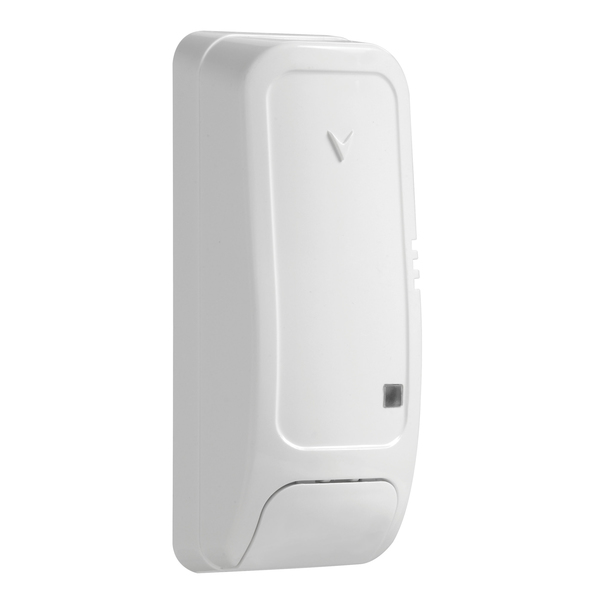How Do I Program a DSC PG9905 Temperature Sensor With a Qolsys IQ Panel 2 Plus?
You can program a DSC PG9905 Temperature Sensor with a Qolsys IQ Panel 2 Plus by putting the IQ Panel 2 Plus into its auto-learn mode, pressing and holding the enroll button on the PG9905 until its LED is solid orange, and then configuring the settings for the DSC PG9905 PowerG Sensor.

Please note that if you want the Qolsys IQ Panel 2 Plus System to report out when an excessive temperature is detected, then you can only use the PG9905 Sensor to monitor for either High or Low temperature. The sensor can only monitor for both high and low temperatures if the system is set to not report out (Sensor Group 51-Temp Non-Reporting). If you want to have the alarm system monitor for both High and Low Temperatures, and have the system report for either activity, then you will need a second PG9905 Sensor. More information on this is covered in Step 4 below.
Complete the following steps to program a DSC PG9905 PowerG Temperature Detector with a Qolsys IQ Panel 2 Plus Security System:
1. Open the DSC PG9905. You should start by opening up the DSC PG9905 Sensor. First, stick a small flathead screwdriver into the tab to pry off the screw cover.

Next, use a Phillips screwdriver to loosen the screw so that you can open the sensor.


2. Access Auto-Learn mode. Now turn your attention to the IQ Panel 2 Plus. You will be putting the system into its auto-enrollment mode so that you can learn-in the PG9905 Sensor. Start from the main screen of the Qolsys IQ Panel 2 Plus. Press the small grey button at the top of the screen. Choose Settings > Advanced Settings > enter the Installer Code (default 1111) > Installation > Devices > Security Sensors > Auto-Learn Sensor. The IQ Panel 2 Plus will now be in its Auto-Learn Mode.

3. Auto-enroll the sensor. On the PG9905, press and hold the Enroll button until the LED light is solid orange. Make sure there is a fresh CR123A battery installed for the PG9905 when doing this. You should get a message on the IQ2+ saying that a PowerG Sensor is trying to learn-in. Press OK when given the option. If you are having trouble, you might try pressing and holding the Enroll button until the red LED blinks three (3) times, indicating that the sensor has been set to factory default. Then begin this step again.


4. Configure the zone settings. You will now go through and configure the settings for the wireless zone. One important thing to note is that you can only have the PG9905 monitor for both High and Low temps if the system is set to not report to the monitoring station when the High or Low threshold is detected. Assuming that you do want the system to report to Alarm.com and the central station (most users do), then you should set the Sensor Type to Temperature for High-Temperature monitoring, or Freeze for Low-Temperature monitoring.
The Sensor DL ID can be left alone since the sensor was auto-enrolled and its Serial Number was learned-in automatically. The Sensor Type should be Temperature if you want High-Temperature monitoring so that the system can report when this condition occurs, or if you are setting the system to not report a signal when the temperature threshold is met. The Sensor Type option should be set to Freeze if you want the sensor to monitor for Low-Temperature so that the system can report the condition to the monitoring station.
- Sensor Type - Temperature: The system is reporting to monitoring for a High-Temperature condition OR The system is not sending a report so that both High and Low-Temperature monitoring can be used locally.
- Sensor Type - Freeze: The system is going to report for Low-Temperature monitoring.
For Sensor Group, you should choose 52-Freeze if you set the Sensor Type to Freeze. If you set the Sensor Type as Temperature, then choose 51-Temp Non-Reporting if you don't want the system to report to Alarm.com and the central station and this condition will be monitored locally only, or choose 53-Temp Reporting if you want the system to report to Alarm.com and the central station when the High-Temperature threshold is detected.
- Sensor Group 51 - Temp Non-Reporting: The system will NOT report to the monitoring station. Both High-Temperature and Low-Temperature monitoring will be available. This option should only be selected if you set the Sensor Type to Temperature.
- Sensor Group 52 - Freeze: The system will report to the monitoring station. Only Low-Temperature monitoring will be available. This option should only be selected if you set the Sensor Type to Freeze.
- Sensor Group 53 - Temp Reporting: The system will report to the monitoring station. Only High-Temperature monitoring will be available. This option should only be selected if you set the Sensor Type to Temperature.
Set the Threshold settings (High and/or Low) to the desired levels. Remember that only one option will be available if you chose a Sensor Group that will have the system report to Alarm.com and/or the monitoring station. Choose a Sensor Name that will help you remember the sensor and not confuse it with others. Choose a Chime Type that you like, or set it to None if you don't want a Chime. Set Voice Prompts ON or OFF depending on whether you want the panel to speak the descriptor when the sensor is activated. Source should be set to PowerG (this should occur automatically during the auto-learn process). Press Add New when finished. You can close the PG9905 Sensor at this time.

Did you find this answer useful?
We offer alarm monitoring as low as $10 / month
Click Here to Learn MoreRelated Products
Related Videos
Related Categories
- Answered


